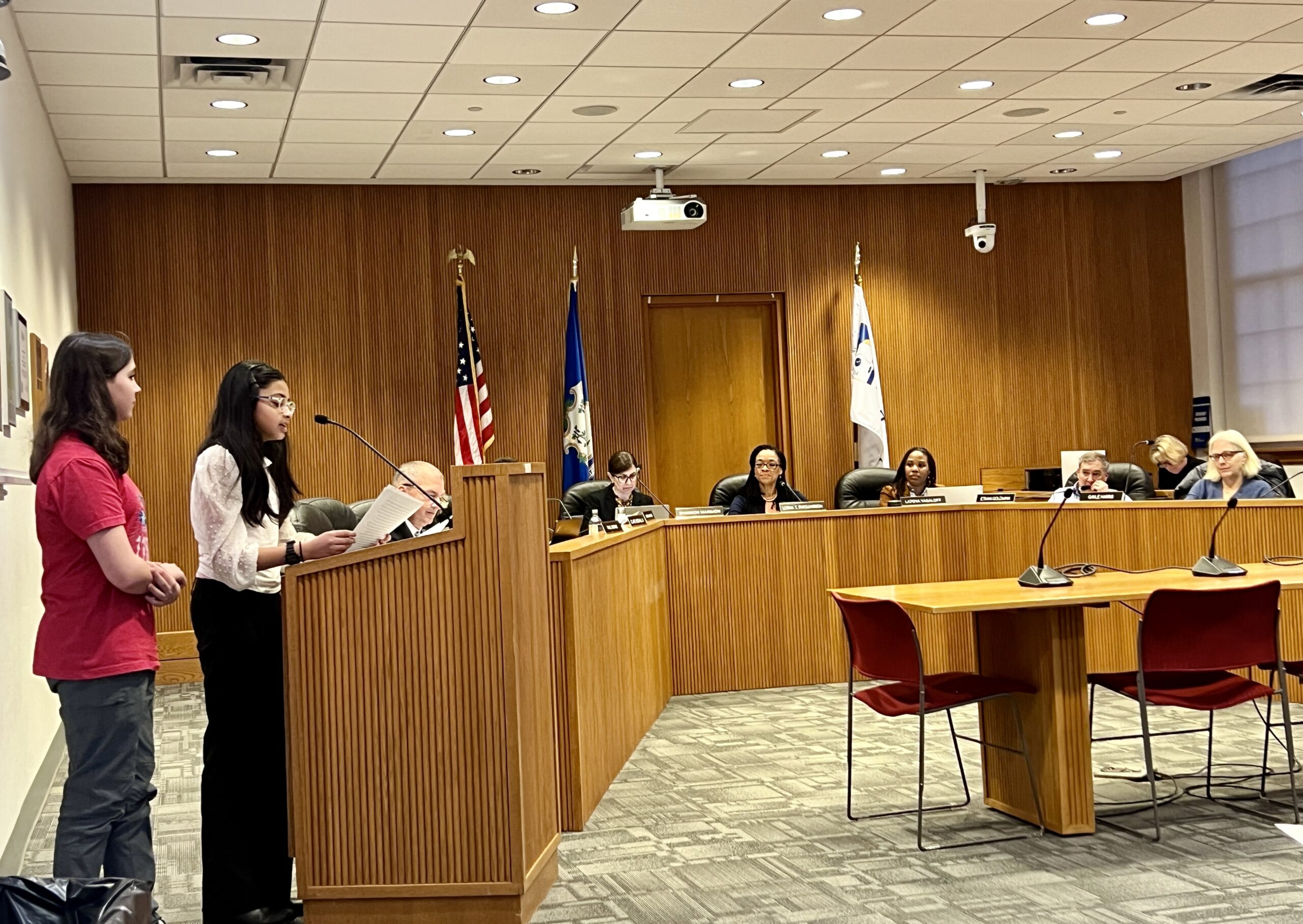Families Address West Hartford Board of Education to Advocate for Smaller Classes

Audio By Carbonatix

Grace Dufour-Guarino (left) and Sufiya Khan, 6th grade Quest students, address the West Hartford Board of Education at a March 26, 2025 public hearing. Photo credit: Ronni Newton
Nearly three dozen people spoke at a West Hartford Board of Education budget hearing on March 26, with most asking for preservation of the existing staffing for the Quest program and for smaller class sizes.
By Ronni Newton
The West Hartford Board of Education will vote Tuesday night on the proposed 2025-26 budget, which was presented by Superintendent Paul Vicinus on March 4 and which totals $215,226,800, representing an overall increase of $14,422,944 (7.2%) over the $200,803,856 budget adopted for the 2024-25 academic year, and in advance of that vote, 34 people addressed the Board at a public hearing held on March 26.
Some were students as young as elementary school, asking the Board not to reduce the number of teachers for Quest – the district’s gifted and talented program for elementary and middle school students in grades 3-8. There were parents of Quest students, and also parents who expressed concern about class sizes at several schools where it appears the number of sections will be close to the maximum recommended limit in certain grades due to projected enrollment.
Much of the proposed school budget increase is driven by salary increases that are part of negotiated collective bargaining agreements, benefit costs, contractual transportation costs, services for students with special needs including out-of-district placement, and inflation.
The proposed budget included a reduction in total staff by 8.2 FTE (full-time equivalent) positions, including 0.7 positions related to the Quest program. The number of elementary school sections is expected to decrease from the current 201 to 196 based on enrollment as well as greater adherence to the district’s long-standing class size guidelines. “We will have a stricter adherence to our class size guidelines” for the coming year, Vicinus said when he summarized the proposed budget at the March 4 Board of Education meeting. The guidelines are 23 or fewer students in grades K-3, and 27 or fewer students in grades 4 and 5.
Students involved in Quest who testified at the public hearing delivered compelling speeches to the Board of Education. Annabelle Brooks, who said she has been part of Quest for five years, said that her teachers, David Lee and Michele Haddock “have always made me feel like my ideas matter. … Quest teachers are already spread across 14 schools, and with cutting the Quest program they will be spread even thinner.
Sufiya Khan and Grace Dufour-Guarino teamed up to speak to the Board, noting that they got into Quest because of their creative writing and art skills. “Quest is amazing but having an amazing teacher makes. Quest even better,” said Grace. “Help, think, and do” are part of the benefit to involvement in Quest, which focuses on teamwork and collaboration, Sufiya said. They said that “losing one teacher will affect the delicate balance of Quest.
Sedgwick Middle School Quest students Harper Lynch and Kara Loveland, also tag-teamed. Part of what Quest has meant to them is pushing through challenges and a chance to go to Iowa, which elicited laughter from the audience. They were referring to the world championships of Odyssey of the Mind, in which many Quest students participate, which is held at Iowa State University. Reductions, for the students in Quest, “is like taking away a pot of gold – or hot glue guns,” they said, adding that Quest is what gets them up in the morning and their “purpose in life and what we live for.”
Dr. Sagar Patel said the neuron spire is different for students who are gifted and talented, “and it’s important that we address this functioning, address their needs” because it’s a form of neurodiversity. His wife, Dr. Melissa Morales, said last year in third grade their son didn’t want to go to school anymore because he wasn’t being challenged. While his teacher didn’t have the resources at that level to create a special curriculum, she did “have another tool in the toolbox” and nominated him for Quest, in which he now participates and says its his favorite part of the day. “The educational needs of the 503 students who take part in the Quest program should not be ignored,” she said.
“Without Quest I would feel that something is missing,” said Graham Johnson, who started in regular Quest in fourth grade and Math Quest (for students who are working at least two grade levels ahead) in fifth grade. He also said there are 26 kids in his regular class, and Quest gives him a chance to escape that chaos.

Council chambers were packed for a public hearing on the West Hartford Pubic Schools budget on March 26, 2025. Photo credit: John Lyons
Along with Quest, class size was the other main topic brought up to the Board of Education.
Lizzy Brooks, a parent who is also a teacher, advocated against reducing elementary school teachers. She specifically cited the enrollment projection for Charter Oak International Academy, where the current third graders are split into four classes of roughly 19 students but are projected to be split into just three larger classes of 24 and 25. That particular cohort “experienced a tragic and traumatic loss of one of their classmates in kindergarten,” she said, and continues to struggle, which will make it much more difficult for their fourth grade teachers to meet the high level of student need. “The Board is proposing cutting funds precisely where they are needed most. … Our students need more and deserve better.”
Stephanie Dominello, who has three children currently at Duffy and an incoming kindergartner, said Duffy again will have the highest average class size in the district at 22, and said some schools are predicted to have classes of 27. “I wonder if you have visited these classrooms,” she said, and noted that the guidelines in other towns such as Farmington and Simsbury are lower. “I worry that larger class sizes will overburden our teachers,” she said.
Jeff Kivlin and his wife grew up in West Hartford and he said they returned to town for the schools. “West Hartford and everything we love about West Hartford was built on this education system,” he said, but the projected 22-student kindergarten classes at Duffy is unacceptable. “If we’re going to pay an extra 7.35% [the overall projected tax increase for the town], we may as well pay 7.5% and get what we want,” he suggested.
Cuts to Quest and increases in class sizes “threaten what makes us, us,” said Morley parent Maryhope Rutherford.
“The strength of Morley is that it strives to create a sense of community,” said parent Jen Long. Having 27 students per class in fifth grade, as initially projected, is too much.
Resident John Lyons, whose three children have all graduated from West Hartford’s public schools, commended the administration and all-volunteer Board of Education for their work. He provided a different perspective and asked families to reach out to the governor and their state legislators. “West Hartford is facing a budget shortfall the likes of which we have not faced in years … in big part because of state cuts in spending where the money is possibly there.” One of the major drivers of the Board of Education budget increase is a shortfall in the reimbursement by the state for excess costs of special education. While the legislature last month supported $40 million in additional funding to assist with a shortfall in the current year’s budget – and while the governor has committed to an extra $40 million in excess cost reimbursement in the 2026-27 fiscal year, “currently there is no funding plan for the excess cost reimbursement in the 2025-26 year,” Vicinus said during his March 4 budget presentation.
In addition to speaking at the public hearing and at Board of Education meetings, residents have also emailed Vicinus and Board members.
In a letter of response regarding the 0.7 FTE reduction in Quest staffing, Vicinus said the recommendation is based on enrollment and scheduling. “The value of our gifted and talented program and the dedication and impact of our staff is unquestionably beyond measure. That said, the realities of our fiscal constraints and the need to balance our staffing with program enrollment is not only a reality but a responsibility,” he wrote.
“The recommended staffing should in no way impact the services provided nor the quality of the program,” stated Vicinus, noting that Quest services are only two to three hours per week, and eight teachers are adequate to instruct 100-125 students on an overall basis in class that are less than eight students per group. “We are maintaining that model so that despite the trimming of FTE, there is no impact on class size nor services rendered,” he said.
Quest staffing has remained largely flat despite decline elementary school enrollment over the past several years, and with the proposed enrollment as well as efficiencies in scheduling, pulling students out of the regular classrooms for Quest will be more efficient. Much of the reduction is also at the middle school level, he added. “I have little doubt that we can support the same high quality Quest program that is a hallmark of the district.”
Regarding class sizes, Vicinus said in response to parents that it’s a delicate balance to support the budget and closely follow class size guidelines. “I more than appreciate and respect the shared concern when class cohorts begin to approach the tipping point in a grade level and the shared relief when a cohort crests above a guideline maximum and a lower class enrollment is achieved. This tug of war between class sizes and the constraints of budget for additional positions (FTEs) occurs annually and across all levels (elementary, middle and high school). This year, the recommended budget is considerably higher based on a number of factors that I’ve spoken about publicly. And while it is true that there are always one or two drivers in the budget that may cause some degree of friction, this is an especially challenging year with a significant number of budget drivers that have all fallen as an increase vs. a savings. In the face of these challenges, my goal is not to raise class sizes, but to pass a budget that preserves and protects the programs and quality of offerings that the community both deserves and expects.”
The enrollment projections and class distributions that were included with the budget documents are based on a “point in time” but those numbers can and will change between now and the end of the summer when classrooms are finalized. Between the initial production of the estimates and March 5 some of the break-points, where classes are either split or combined, had changed. For example, the addition of one extra student in fifth grade at Morley led to a projection of three fifth grade classes of 18-19, and Braeburn is predicted to go from two 27-student fourth grade sections to three classes of 18-19 students due to one more student.
“This updated data shows potentially different points of both tension and relief. It illustrates the impact of a difference of one or two students when cohort totals get close to class-size guidelines. It also demonstrates the flexibility of staffing not yet assigned and a different potential placement of that available staffing to relieve some but perhaps not all tension points. We work very hard to provide equitable staffing across all of the neighborhood schools based on the enrollment. In the summer months, we will define those available positions and if it becomes necessary to create a section over the budget, we will do so as we did this past year. The projections we have today are our best guess at where we could be in the fall based on all of the information available to us at the moment,” Vicinus said.
“I want to let you know that regardless of where we land with sections, I have great confidence in our systems, our schools and our teachers,” he added. “While larger class sizes feel like a new phenomenon, this situation is far from unprecedented and we have worked with class sizes at or above 25 frequently in the past.”
The Board of Education budget – which will be adopted on April 1 – is part of the town’s overall general fund budget, and while the Council can change the overall amount allocated to the district, it cannot adjust specific items of the education budget.
Comments regarding the general fund budget can be submitted in writing via email to [email protected]. Three people spoke at a public hearing on April 1, all expressing concerns about the sustainability of continued large tax increases. Another public hearing is scheduled for Tuesday, April 8, at 6 p.m. at Town Hall.
The Town Council is scheduled to adopt the overall budget on Tuesday, April 22, with that meeting beginning at 7:30 p.m.
Like what you see here? Click here to subscribe to We-Ha’s newsletter so you’ll always be in the know about what’s happening in West Hartford! Click the blue button below to become a supporter of We-Ha.com and our efforts to continue producing quality journalism.



